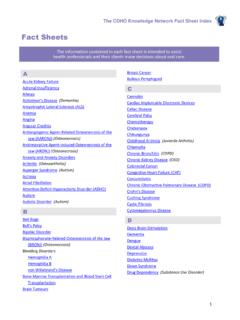Transcription of 7.01.574 Implantable Peripheral Nerve Stimulation for the …
1 MEDICAL POLICY Implantable Peripheral Nerve Stimulation for the Treatment of Chronic Pain of Peripheral Nerve Origin Effective Date: Mar. 1, 2022 RELATED MEDICAL POLICIES: Last Revised: Feb. 21, 2022 Interferential Current Simulation Replaces: N/A Electrical Stimulation Devices Percutaneous Electrical Nerve Stimulation (PENS) and Percutaneous Neuromodulation Therapy (PNT). Occipital Nerve Stimulation Peripheral Subcutaneous Field Stimulation Spinal Cord and Dorsal Root Ganglion Stimulation Select a hyperlink below to be directed to that section. POLICY CRITERIA | CODING | RELATED INFORMATION. EVIDENCE REVIEW | REFERENCES | HISTORY. Clicking this icon returns you to the hyperlinks menu above. Introduction Peripheral nerves are the nerves that connect the brain and the spinal cord to the body. One way of trying to control pain that arises from Peripheral nerves calls for implanting a device that sends low levels of electricity to stimulate part(s) of the Nerve . This electrical current is thought to interfere with how the Nerve transmits pain signals.
2 Stimulating part(s) of a Peripheral Nerve to try to treat pain is investigational. That means this technique needs more study to see if it is safe and effective. Note: The Introduction section is for your general knowledge and is not to be taken as policy coverage criteria. The rest of the policy uses specific words and concepts familiar to medical professionals. It is intended for providers. A provider can be a person, such as a doctor, nurse, psychologist, or dentist. A provider also can be a place where medical care is given, like a hospital, clinic, or lab. This policy informs them about when a service may be covered. (02-21-2022). Policy Coverage Criteria Procedure Investigational Implantable Peripheral A trial or permanent placement of an Implantable Peripheral Nerve Stimulation Nerve stimulator for the management of chronic pain of Peripheral Nerve origin is investigational for all indications. Coding Code Description CPT. 64555 Percutaneous implantation of neurostimulator electrode array; Peripheral Nerve (excludes sacral Nerve ).
3 64575 Open implantation of neurostimulator electrode array; Peripheral Nerve (excludes sacral Nerve ). 64585 Revision or removal of Peripheral neurostimulator electrode array 64590 Insertion or replacement of Peripheral or gastric neurostimulator pulse generator or receiver, direct or inductive coupling 64595 Revision or removal of Peripheral or gastric neurostimulator pulse generator or receiver HCPCS. C1767 Generator, neurostimulator ( Implantable ), nonrechargeable C1778 Lead, neurostimulator ( Implantable ). L8679 Implantable neurostimulator, pulse generator, any type L8680 Implantable neurostimulator electrode, each L8681 Patient programmer (external) for use with Implantable programmable neurostimulator pulse generator, replacement only L8682 Implantable neurostimulator radiofrequency receiver L8683 Radiofrequency transmitter (external) for use with Implantable neurostimulator radiofrequency receiver Page | 2 of 10 . Code Description L8685 Implantable neurostimulator pulse generator, single array, rechargeable, includes extension L8686 Implantable neurostimulator pulse generator, single array, nonrechargeable, includes extension L8687 Implantable neurostimulator pulse generator, dual array, rechargeable, includes extension L8688 Implantable neurostimulator pulse generator, dual array, nonrechargeable, includes extension L8689 External recharging system for battery (internal) for use with Implantable neurostimulator, replacement only Note: CPT codes, descriptions and materials are copyrighted by the American Medical Association (AMA).
4 HCPCS. codes, descriptions and materials are copyrighted by Centers for Medicare Services (CMS). Related Information Example of Patient Components for the Bioness StimRouter . StimRouter Lead: The StimRouter Lead is flexible and approximately 15 cm (6 inches) in length. The lead has a Stimulation end and a receiver end. The Stimulation end is implanted near or at the targeted Peripheral Nerve and the receiver end is implanted near the skin surface. The receiver end receives the Stimulation signal from the external pulse transmitter (EPT) and then sends the signal through the lead to the Stimulation end. StimRouter External Pulse Transmitter (EPT): The StimRouter EPT generates the Stimulation signal and transmits the signal through the StimRouter Electrode to the StimRouter Lead. The EPT snaps onto the StimRouter Electrode and responds to wireless commands from the Patient Programmer. StimRouter Electrode: The StimRouter Electrode features: Two gel pads that adhere the StimRouter Electrode to the skin.
5 The gel pads also transmit the Stimulation signal from the EPT to the receiver end of the lead. o The StimRouter Electrode is disposable and can be reused by the same patient as long as the gel pads are intact and can fully adhere to the skin or for a maximum of four days of use. Page | 3 of 10 . Patient Programmer: The Patient Programmer communicates wirelessly with the EPT. (external pulse transmitter). The Patient Programmer is used to turn Stimulation on and off, to adjust the Stimulation intensity and to select a Stimulation program. Contraindications: Patients who have any active implanted devices such as an implanted demand cardiac pacemaker, Implantable cardioverter defibrillator (ICD), other implanted active devices, or any metallic implant in the immediate area intended for implant. Source: Accessed March 15, 2021. Evidence Review Description Implantable Peripheral Nerve Stimulation (PNS) is a type of neuromodulation therapy in which electrodes are surgically placed next to a selected Peripheral Nerve considered to be the source of chronic pain.
6 ( Peripheral nerves are nerves located outside of the brain and spinal cord). In this type of treatment, the electrode(s) delivers electrical impulses to the affected Nerve . This electrical current is thought to disrupt the normal transmission of pain signals leading to reduced levels of pain. Page | 4 of 10 . Background Peripheral Nerve Stimulation is similar to spinal cord Stimulation in that it is typically a two-step process. Initially, a temporary electrode is temporarily implanted for a trial period, usually less than 5 days. The electrode is connected to an external device, and if it successfully reduces the pain by at least 50%, then either a multi-electrode lead is permanently implanted and connected to a pulse generator placed in the body or the electrode responds to a hand-held, wireless external pulse transmitter that patients control according to their pain management needs via a patient programmer. Implantable Peripheral Nerve Stimulation differs from other electrical Stimulation therapies in that the origin of pain is from a Peripheral Nerve and the electrical impulses are delivered directly to the Nerve versus the surrounding tissues or spine.
7 Other electrical Stimulation therapies: Spinal cord Stimulation delivers electrical impulses to the spine. Transcutaneous electrical Nerve Stimulation (TENS) delivers electrical impulses to the surface of the skin at the site of pain. Percutaneous electrical Nerve Stimulation (PENS) delivers electrical impulses via needle electrodes inserted into the skin around or immediately adjacent to the nerves serving the painful area. The Stimulation devices used in percutaneous electrical Nerve Stimulation and percutaneous neuromodulation therapy are not implanted. Percutaneous neuromodulation therapy (PNT) delivers electrical impulses through very thin filament electrode arrays inserted directly into the deep tissues near the area causing the pain. (eg, Deepwave , Percutaneous Neuromodulation Therapy ). Peripheral subcutaneous field Stimulation (PSFS) delivers electrical impulses via electrodes placed subcutaneously under the skin over the area of maximal pain. In Peripheral Nerve field Stimulation , a field of pain is targeted rather than specific nerves.
8 (eg, SPRINT ). Chronic pain of Peripheral Nerve origin is experienced by many; however, its etiology is not clearly known, making treatment of this type of pain challenging. Currently available treatment strategies are often insufficient to treat chronic pain of Peripheral Nerve origin, prompting a renewed interest in the use of neuromodulation techniques in the treatment of chronic pain of Peripheral Nerve origin that is refractory to first-line treatments such as analgesics, antidepressants, anticonvulsants, and physical therapy. Page | 5 of 10 . Peripheral Nerve Stimulation was first introduced in the mid-1960s. Since that time, it has been investigated in the treatment of low back pain, headaches, median Nerve neuropathy, ilio- inguinal neuralgia, trigeminal neuralgia, and complex regional pain syndrome and approved for use in Europe and Australia. It is however, considered off-label in the United Summary of Evidence For individuals with chronic pain of Peripheral Nerve origin, the evidence includes a randomized controlled trial (RCT), an open label trial, and case series.
9 Relevant outcomes are symptoms, functional outcomes, quality of life and treatment-related morbidity. The single randomized controlled trial, which used a crossover design, did not compare Peripheral Nerve Stimulation (PNS) with alternatives. Improvement in pain was statistically significant between the randomized groups and again in the partial crossover period. Efficacy was evaluated for 3. months. Safety was assessed through one-year follow-up with no serious adverse events related to the device3. However, the results need confirmation in larger sample sizes and additional RCTs with longer follow-up to draw conclusions on safety and efficacy. The open label study had methodological limitations including, a small sample size of 8 patients with carpal tunnel syndrome, and no mention of follow-up after the device was explanted after five days of Case series are insufficient to evaluate pain outcomes due to the variable nature of pain and the subjective nature of pain outcomes.
10 Prospective controlled trials comparing PNS to alternative treatment modalities are needed to determine the efficacy of PNS for chronic pain of Peripheral Nerve origin. There are no evidence-based clinical practice guidelines that recommend the use of Implantable Peripheral Nerve Stimulation for treatment of chronic pain of Peripheral Nerve origin. The evidence is insufficient to determine the effects of the technology on health outcomes. Ongoing and Unpublished Clinical Trials A currently ongoing trial that might influence this review are listed in Table 1. Page | 6 of 10 . Table 1. Summary of Key Trials NCT No. Trial Name Planned Completion Enrollment Date Ongoing NCT02873312a overactive bladder Treatment Using StimRouter 180 July 2021. Neuromodulation System: A Prospective Randomized Trial NCT03877653 Freedom-1 Study for Chronic Knee Pain 100 Oct 2024. NCT: national clinical trial a Denotes industry-sponsored trial Medicare National Coverage Medicare has a national coverage determination for Electrical Nerve Stimulators ( ) for implanted Peripheral Nerve stimulators since Effective 8/27/2018, Noridian Healthcare Solutions, LLC.













